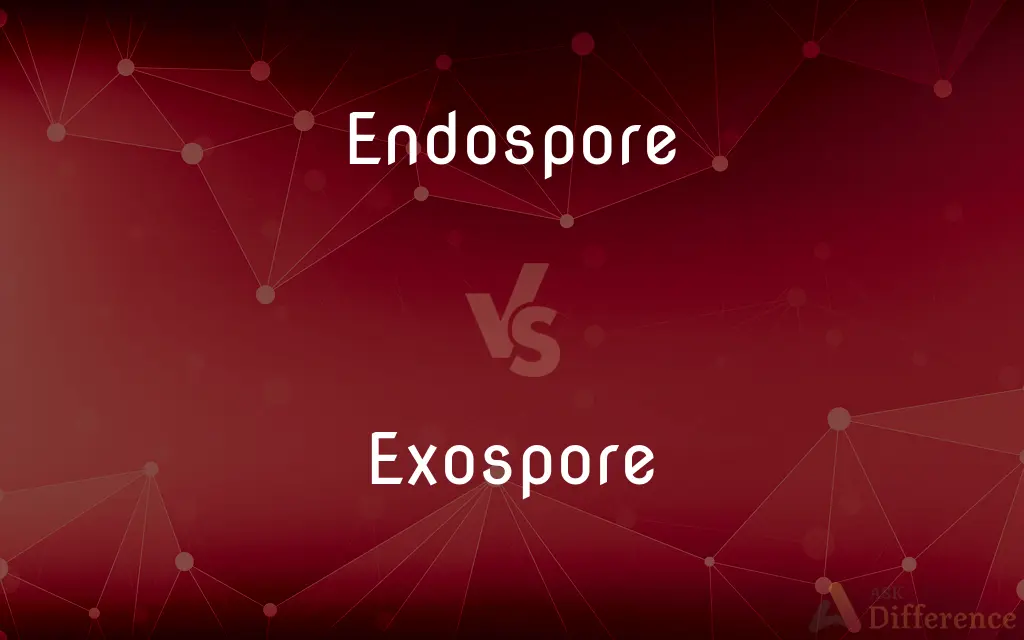Endospore vs. Exospore — What's the Difference?
By Tayyaba Rehman — Updated on September 21, 2023
An endospore is a resistant, dormant structure formed within bacteria, while an exospore is a spore developing outside the mother cell, primarily in fungi.

Difference Between Endospore and Exospore
Table of Contents
ADVERTISEMENT
Key Differences
An endospore is a unique structure produced mainly by certain bacteria, such as Bacillus and Clostridium, as a survival mechanism during unfavorable conditions, whereas an exospore is a reproductive structure observed in fungi and some algae, arising externally from a mother cell.
Endospores are characterized by their resilience, withstanding extreme temperatures, desiccation, and chemicals, enabling bacteria to survive in dormant states for long periods. In contrast, exospores are primarily for reproduction and are not necessarily built for such extreme resistance.
The formation of an endospore, known as sporulation, is a complex process that results in a tough, multilayered structure. On the other hand, the formation of an exospore often involves simpler budding processes or division in fungi.
Bacterial endospores are often problematic in medical and industrial settings due to their resistance, making sterilization challenging. Exospores, being reproductive structures in fungi, have different implications, such as propagation or distribution of fungal species.
Both endospores and exospores play vital roles in their respective organisms' life cycles. While endospores ensure the survival of bacteria under harsh conditions, exospores aid in the reproduction and spread of fungal species.
ADVERTISEMENT
Comparison Chart
Organisms
Found in certain bacteria (e.g., Bacillus, Clostridium)
Primarily in fungi and some algae
Primary Function
Survival during unfavorable conditions
Reproduction
Location
Formed within bacterial cell
Develops outside the mother cell
Resilience
Highly resistant to extreme conditions
Not as resistant as endospores
Formation Process
Complex sporulation
Often involves budding or simpler division
Compare with Definitions
Endospore
A dormant structure within bacteria
Bacteria produce an endospore when faced with unfavorable conditions.
Exospore
A spore formed externally to the mother cell
The fungus produced an exospore for reproduction.
Endospore
Allows bacteria to persist for long periods
The ancient bacteria revived from an endospore were dormant for millions of years.
Exospore
Helps in fungal propagation and spread
The wind carried the exospore to a new location.
Endospore
Highly resistant to harsh environments
The endospore can withstand boiling water.
Exospore
Primarily a reproductive structure in fungi
The presence of an exospore indicates the fungus's reproductive phase.
Endospore
Formed as a survival mechanism
When nutrients are scarce, some bacteria form an endospore.
Exospore
Arises through budding or division
The exospore developed after the fungus underwent budding.
Endospore
Characterized by a tough outer coat
The endospore's coat protects it from various threats.
Exospore
Not necessarily built for extreme resistance
Unlike an endospore, the exospore can't withstand boiling temperatures.
Endospore
An endospore is a dormant, tough, and non-reproductive structure produced by some bacteria in the phylum Firmicutes. The name "endospore" is suggestive of a spore or seed-like form (endo means within), but it is not a true spore (i.e., not an offspring).
Exospore
The outermost layer of the wall of certain spores.
Endospore
The inner layer of the wall of a spore.
Exospore
An asexual spore developed externally by budding, as from a sporophore.
Endospore
An asexual spore developed within a cell, as that formed by some bacteria.
Exospore
The outer layer of a spore, especially in some algae and fungi.
Endospore
The inner layer of a spore.
Exospore
The extreme outer wall of a spore; the epispore.
Endospore
A small vegetative spore produced by some bacteria.
Endospore
The thin inner coat of certain spores.
Endospore
A small asexual spore that develops inside the cell of some bacteria and algae
Common Curiosities
Where are exospores primarily found?
Exospores are primarily observed in fungi and some algae.
Are endospores infectious?
Yes, certain bacterial endospores can cause diseases when they germinate.
How are exospores formed?
Exospores often arise through budding or division processes in fungi.
Are exospores unique to fungi?
While commonly found in fungi, exospores also appear in some algae.
What is the primary role of an exospore in fungi?
The primary role of an exospore in fungi is reproduction.
What triggers endospore formation in bacteria?
Unfavorable conditions, like nutrient scarcity, often trigger endospore formation.
Why are exospores important in fungal life cycles?
Exospores play a vital role in reproduction, allowing fungi to propagate and spread.
How can one destroy bacterial endospores?
High-pressure, high-temperature sterilization methods are effective against endospores.
What is an endospore's primary function?
An endospore acts as a survival mechanism for bacteria during unfavorable conditions.
Why are endospores hard to destroy?
Due to their multi-layered structure and resilience, endospores can withstand extreme conditions.
Do exospores contribute to fungal disease spread?
Yes, exospores can aid in the distribution and propagation of pathogenic fungi.
Do all bacteria produce endospores?
No, only specific genera like Bacillus and Clostridium form endospores.
How do endospores return to an active state?
Endospores can germinate, returning the bacterium to its vegetative state when conditions become favorable.
Which is more resilient, an endospore or an exospore?
An endospore is generally more resilient than an exospore.
Can exospores resist extreme conditions like endospores?
Exospores are not as resistant as endospores and usually don't withstand extreme conditions.
Share Your Discovery

Previous Comparison
Meager vs. Minute
Next Comparison
Law vs. EquityAuthor Spotlight
Written by
Tayyaba RehmanTayyaba Rehman is a distinguished writer, currently serving as a primary contributor to askdifference.com. As a researcher in semantics and etymology, Tayyaba's passion for the complexity of languages and their distinctions has found a perfect home on the platform. Tayyaba delves into the intricacies of language, distinguishing between commonly confused words and phrases, thereby providing clarity for readers worldwide.
















































